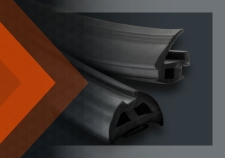
As well as security hardware, Seals and Gaskets are an important aspect of any door or window. There are a variety of types and designs of seals, depending on the style and profile of the opening. These seals are often very small and measuring dimensions can therefore be problematic. Great care must be taken to ensure accurate measurements, and all dimensions must be accounted for if replacing an old seal or gasket. If an incorrect version is used it can cause issues with draughts, leaks, hard-to-close doors and windows or may not fit in the profile at all. For this reason, it can be hard to know where to start in identifying a suitable replacement for your old seal or gasket.
Please note that when measuring seals and gaskets, all measurements are taken from a cross-section of the product, and then the required amount needed is specified in metres. Duffells generally sell these products in quantities of pre-cut 10m strips, or the manufacturer's tub quantities, which vary depending on the product but can be anything between 50m and 250m. Please enquire with our sales team if you wish to know the tub quantity of a specific product.
What are the types of Seals and Gasket available?
Firstly, it is important to understand the type of product in question. The common types of rubber gasket available at Duffells include:
Wedge Gasket Seal
Wedge gaskets are used on glazed units to form a seal between the glass and the frame material.
Wedge gaskets are typically made from resilient materials like rubber or synthetic elastomers. To differentiate between different sizes or profiles of gaskets, manufacturers often use color-coding. Each colour represents a specific size or shape of the gasket, making it easier for installers to select the appropriate gasket for a particular application. However, it's important to note that colour codes may vary between manufacturers, so precise measurements should also be considered. An example is below with the measurements required illustrated (the profile size is 4.0mm and the channel width is 2.6mm):
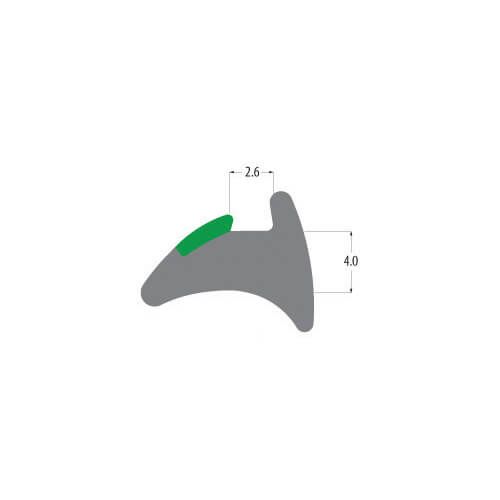
Structure and Design: Wedge gaskets have a wedge-like shape with a tapered cross-section, narrowing towards one end. They are typically made from materials like rubber or synthetic elastomers.
Sealing Function: The primary function of a wedge gasket is to fill the gap or space between two surfaces, such as a glass pane and its surrounding frame or the frame and mullions in a window or door. When the gasket is installed, it compresses to create a tight seal, preventing the ingress of air, water, dust, or other environmental elements. This sealing action helps maintain indoor comfort, prevent drafts, and protect against weather conditions.
Common Use: Wedge gaskets are often found in externally beaded window and door units. In such units, the gasket is positioned on the exterior side, providing an attractive and weather-resistant seal. This design choice allows for easy installation and replacement since the gasket can be accessed and replaced from the outside.
Installation: Installing a wedge gasket involves pressing it into a channel or groove within the frame or sash where the glass is situated. As the gasket is pushed into place, it compresses and forms a secure seal around the perimeter of the glass, ensuring a snug fit and preventing leaks or air infiltration.
Flipper Gasket Seal
Flipper gasket can be thought of as any seal which incorporates an angled flap which sits against a closing surface to form a seal. Often these will be attached to an integrated rubber frame which pushes into a profile or channel to fit but can also be an adhesive or wedge-fit type of gasket. Flipper Gaskets are typically made from resilient materials like rubber or synthetic elastomers. When measuring flipper gasket it is important to measure both the angled flap and the base or section of the profile as with this example (the angled flap measures 7.1mm and the width of the profile section is 5.1mm):
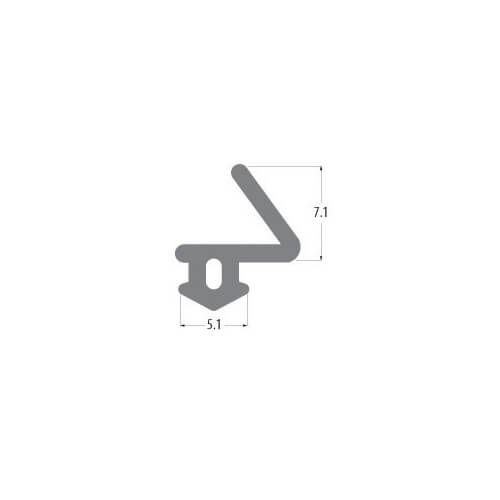
Structure and Design: Flipper gaskets are designed with flexible fins or projections along their length, typically made of rubber or synthetic elastomers. These fins allow the gasket to compress and retract as needed.
Function: Flipper gaskets serve to provide weatherproofing and ensure smooth operation in sliding or sash windows, sliding glass doors, and similar fixtures.
Sealing and Operation: They create a seal against air and water when the window or door is closed, and they reduce friction between moving parts, allowing for easy opening and closing.
Installation: Flipper gaskets are installed in a groove or channel within the frame or sash, and they maintain a continuous seal even when the surfaces are not perfectly square or level.
Bubble Gasket Seal
Bubble gasket describes any gasket where the extruded profile contains a fully surrounded “Bubble” or pocket of air. This bubble is squashed or compressed by two meeting surfaces to form a seal between them. Again, these can be attached to various bases such as extruded profile-specific frames, or flat self-adhesive bases. As with other gaskets, there is a vast array of different shapes and sizes of bubble gaskets, and we are only able to stock a concise range of common types. Please see below for a typical bubble gasket with the required measurements:
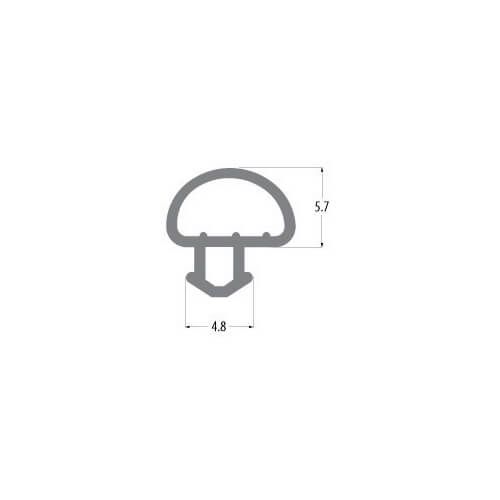
Structure and Design: Bubble gaskets are characterized by a row of interconnected, hollow bubbles or bulbs along one side of the gasket. These bubbles are typically made of rubber or synthetic elastomer materials.
Versatile Sealing: Bubble gaskets are highly versatile and can conform to irregular or uneven surfaces. When compressed, the bubbles flatten out to fill gaps and create a seal.
Primary Use: They are commonly used in doors, windows, automotive seals, and electrical enclosures to provide airtight and watertight seals.
Installation: Bubble gaskets are installed in a groove or channel within the frame or sash, ensuring that the bubble side makes contact with the opposing surface when closed.
Foam Seals
Foam Seals are another common type of seal made from extruded compressible foam, in a specific shape designed to suit a specific door profile. These will usually have a reinforced section that slides or pushes into a channel on the door or window which holds it in place.
Here is a common example of a Q-Lon foam weather seal:

The darker section is the reinforced area which maintains shape and helps to keep the seal in place, whereas the rest of the seal is made from compressible foam. Again, it is important to obtain measurements of both the seal area itself and the re-enforced section which is retained inside the profile. Some foam seals are adhesive-backed so that they can be face fixed to a surface, here is an example:

WOOL PILE DRAUGHT EXCLUDER
Wool Pile draught excluder is a brush-like strip which is used to fill gaps between surfaces where draughts may otherwise get through and insulate the opening helping to retain heat. Due to its brush-like construction, it is ideal for use where the seal may be swept over by a passing surface such as the edge of a door or frame during the door’s operation, as the flexible wool pile brush may not wear down, collapse, or perish as quickly.
Duffells supplies wool pile draught excluder in 2 sizes, either PILE550M which has a base width of 4.8mm and a pile height of 5.5mm or PILE750M which has a base width of 6.9mm and a pile height of 7mm. Both come supplied in 50m lengths. The base of the pile seal usually slides into a channel, which may be part of the construction of the surface or added afterwards.
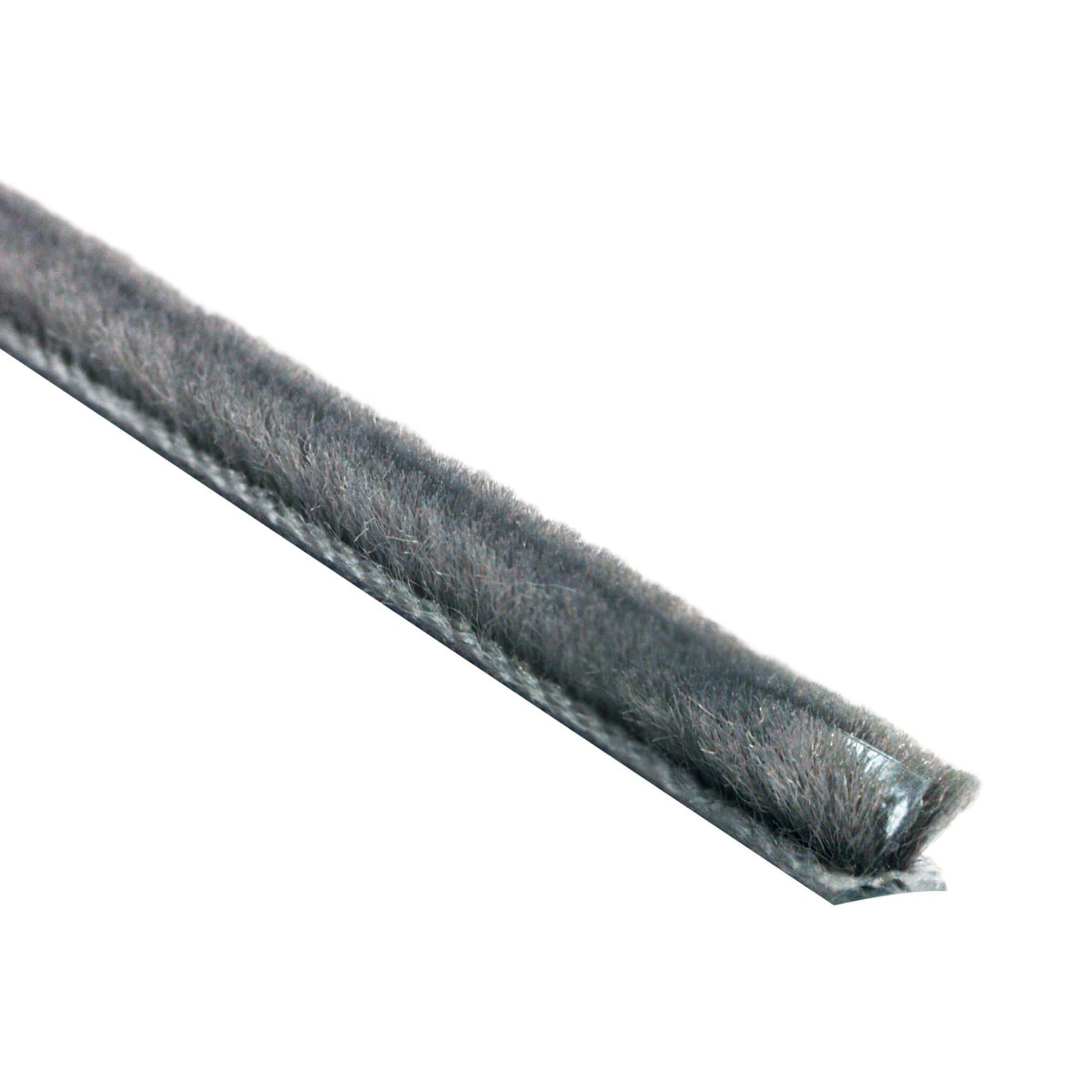
Pile Strip slid into place in a pre-existing channel

Other seals
Duffells range of seals also includes some self-adhesive universal-type seals manufactured from an EPDM rubber which has an adhesive backing. These can be used to conveniently seal gaps where no provision has been made for other types of seals to be installed such as on plain or damaged meeting surfaces.
These are stocked in 2 different profile shapes, both are stocked in white and brown.
E strip features 3 flipper type extrusions
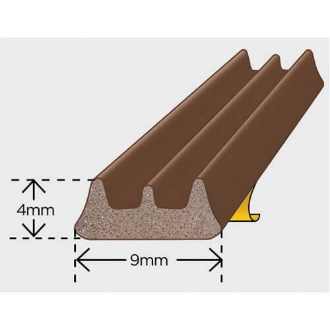
The P strip contains a bubble type compressible section.
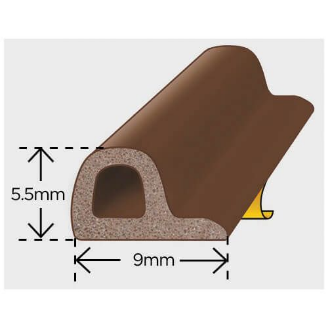
Aluminium Extrusions
Rubber seals are also present on some of the range of Exitex aluminium door accessories that we stock. Unfortunately, the seals that come included with these products, such as weather bar and thresholds, are not available separately from stock, so please contact us to enquire about the availability of replacement seals with our special orders team.
VERSA Universal Seals
If you are unable to identify a suitable seal from the measurements and the options in stock, there are universal type seals by VERSA available which may be suitable for your application.
VERSA offer a range of universal bubble/flipper gaskets in 3 different base sizes, as well as a range of universal wedge gaskets in 3 different code sizes which are often useful for the replacement of gasket that is either hard to identify or which is not stocked and must be ordered in too large a quantity if ordered in via special orders.
VERSA Universal Flipper/Bubble Gasket
The VERSA universal flipper/bubble gasket is capable of use as either a flipper or a bubble gasket due to the design of the flipper blade which meets an upstand on the base to form a full enclosure once compressed. The flipper/bubble gasket can replace multiple other flipper and bubble gaskets with just the 3 sizes in the range, 2.5, 3.5 and 4.8mm bases. It can cover gaps up to 7.3mm and compresses to just 2mm thick, and is able to follow contours on beveled windows. It is supplied in 10m lengths and is a great option for stocking as it covers many applications.
VERSA Universal Wedge Gasket
The VERSA universal wedge gasket is capable of replacing multiple sizes of traditional wedge gasket. 3 sizes are offered, a 2-3mm core, a 4-5mm core and a 6-7mm core. These 3 sizes cover most existing traditional wedge gasket profiles and again they are supplied bagged in 10m lengths offering an excellent option for stockists wanting to cover several bases.
This blog is intended as a guide to the operation of the products in it. Whilst we may describe standards and scenarios, we cannot recommend the use of these products for a specific environment or circumstance. The specification of any product must be undertaken by the professional on-site who has knowledge of the building, its inhabitants, its intended use, and any other requirements. We cannot say that a product is suitable for a specific use case.



